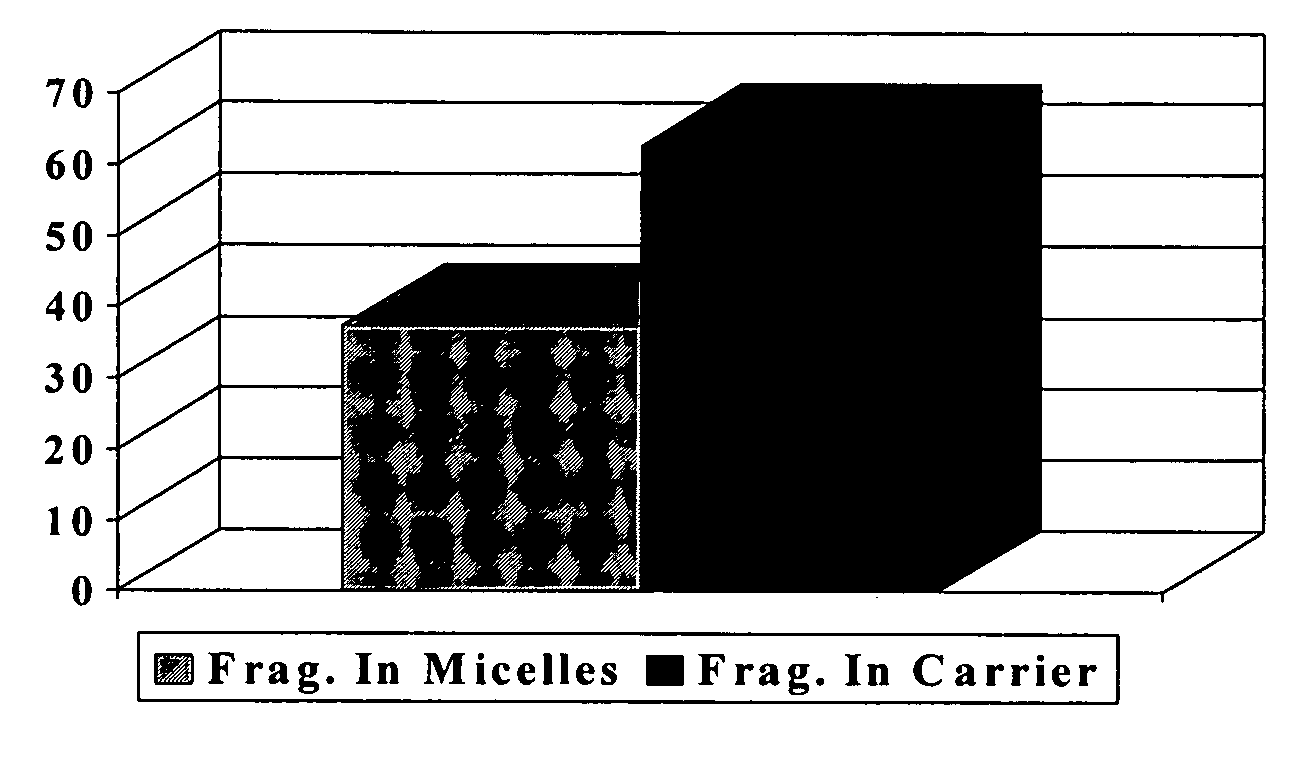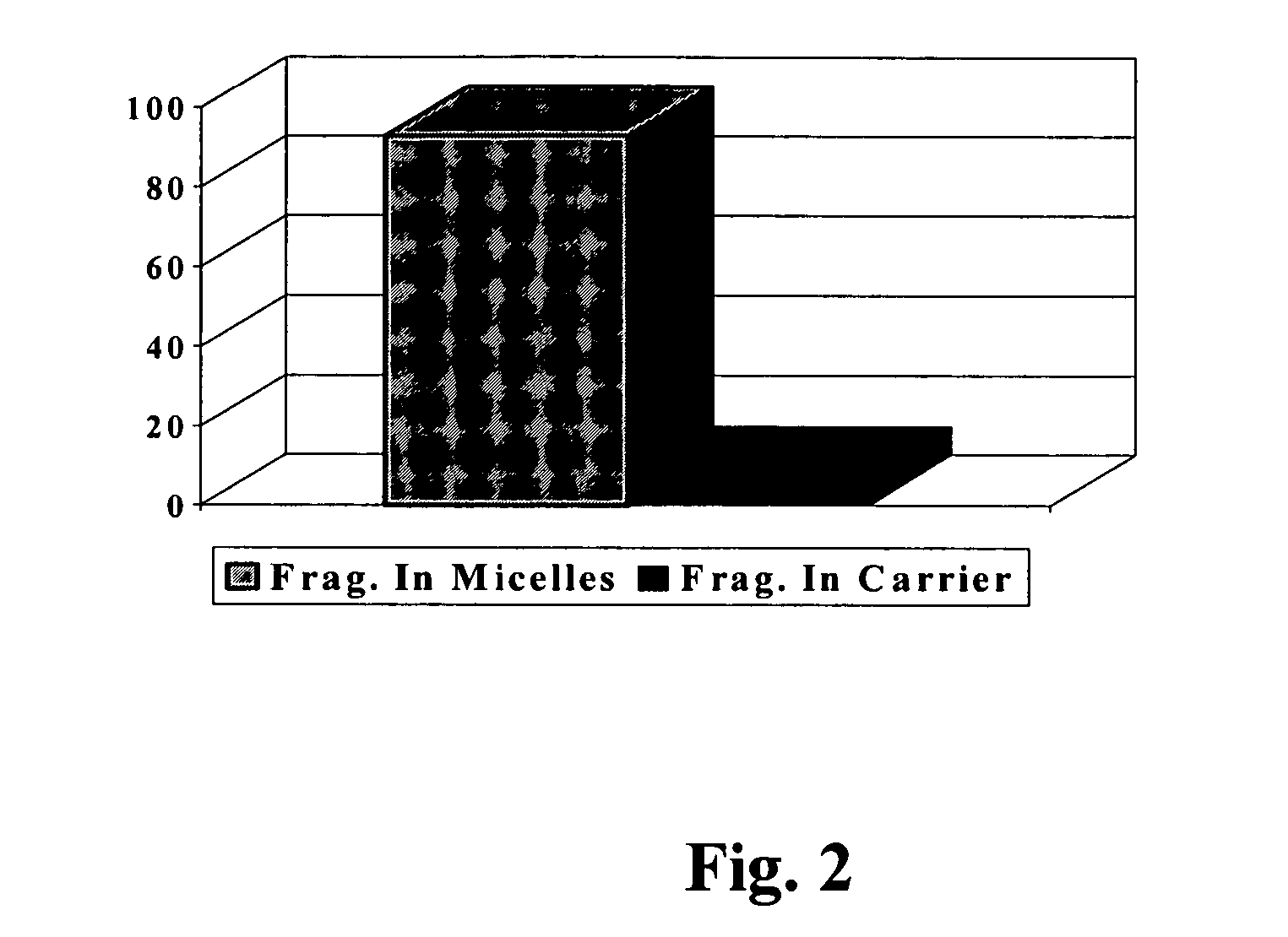Fragrance delivery system for surface cleaners and conditioners
a technology of surface cleaners and conditioners, applied in the direction of perfume formulations, detergent compounding agents, hair cosmetics, etc., can solve the problems of limiting the amount of fragrance deposition on the surface treated with the composition, and affecting the effect of fragrance binding
- Summary
- Abstract
- Description
- Claims
- Application Information
AI Technical Summary
Benefits of technology
Problems solved by technology
Method used
Image
Examples
example 1
Preparation of a Body Wash Composition According to the Invention
[0068]Two body wash compositions were prepared by admixing, as described below, the following ingredients in the proportions indicated:[0069]1) Fragrance # 1: 1.0 g of a fragrance composition containing the following raw materials:
[0070]Limonene (15.5%); Benzyl Acetate (6.25%); Cyclohexanol Acetate (2.5%); Cyclohexanol, 2-(1,1-dimethylethyl)-, acetate (6.25%); 2-methyl Undecanal (2.75%); 4-(1,1-dimethylethyl)-alpha methyl benzenepropanal, (18.75%); Cyclopentaneacetic acid, 3-oxo-2-pentyl-, methylester (29.25%); Hexyl Salicylate (18.75%).[0071]2) Polymers for internal dispersible phase (fragrance carrier component): 1.0 g of Isomyristyl Alcohol Dimer / IPDI (MONODERM® MPI-1-14) or 1.0 g of Hydrogenated Castor Oil / IPDI Copolymer[0072]3) Polymer for external dispersing phase (fragrance deposit / delivery component): 0.5 g of Acrylamidopropyltrimonium Chloride (and) Acrylamide copolymer (SALCARE® SC-60)[0073]4) Primary Surfact...
example 2
Application of the Body Washes Described in Example 1 and Comparative Example 1, and Measurement of the Fragrance Release from the Surfaces Treated
[0093]Fragrance deposition analyses from the body washes previously described in Example 1 (Composition A) were carried out on wool swatches. The wool swatches were 2½ wide by 4 inches long (1 gram) and were washed once with 0.5 g of the body wash formulation in question. The wool swatches were soaked in 500 ml of water before washing and the wash formula was applied on their surface. The wash was then gently stroked, rubbed and foamed on the wool swatch for about 30 seconds, after which the latter was rinsed in running tap water at 30 C. Fragrance analyses on the wool swatches were carried out by SPME (Solid Phase Micro Extraction) methods.
[0094]Wool swatches prepared for SPME analysis were put into vials after various periods of time had elapsed since the washing process. The SPME analysis of fragrance left on the wool after each period...
example 3
Application of Body Washes to Wool Surfaces and Measure of Fragrance Deposition on the Surface Treated
[0099]A comparative analysis of fragrance deposition attained with prior art delivery systems, against the GLPPD object of the present invention, is illustrated in FIG. 3. This Figure represents a typical chromatographic analysis of a fragrance deposited on wool after washing with two body washes, namely, one containing myristyl myristate and the other polymer isomyristyl alcohol dimer / IPDI as the fragrance carrier. In the “Y” axis of this graph are represented the area count units associated with each raw material intensity, while in the “X” axis are represented the raw material chromatographic peaks by retention time. The invention body wash composition used in this experiment was previously already described in Example 1. Fragrance raw material analysis was carried out by SPME in the head space of vials containing the wool swatch. The composition of the model and their associated...
PUM
| Property | Measurement | Unit |
|---|---|---|
| diameter | aaaaa | aaaaa |
| particle size | aaaaa | aaaaa |
| particle size | aaaaa | aaaaa |
Abstract
Description
Claims
Application Information
 Login to View More
Login to View More - R&D
- Intellectual Property
- Life Sciences
- Materials
- Tech Scout
- Unparalleled Data Quality
- Higher Quality Content
- 60% Fewer Hallucinations
Browse by: Latest US Patents, China's latest patents, Technical Efficacy Thesaurus, Application Domain, Technology Topic, Popular Technical Reports.
© 2025 PatSnap. All rights reserved.Legal|Privacy policy|Modern Slavery Act Transparency Statement|Sitemap|About US| Contact US: help@patsnap.com



